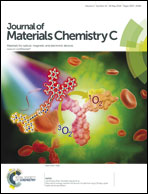Surface-initiated atom transfer radical polymerization of glycidyl methacrylate and styrene from boron nitride nanotubes
Abstract
Boron nitride nanotubes (BNNTs) grafted with polyglycidyl methacrylate (PGMA) and polystyrene (PSt) brushes are described. This surface modification of BNNTs with polymer brushes is efficiently achieved involving only two steps: the introduction of benzyl bromide ATRP initiating sites on the BNNTs’ surface by a one-step radical addition method and the surface-initiated atom transfer radical polymerization (SI-ATRP) of GMA or St from the initiator immobilized BNNTs surface. The structure and properties of the resultant hybrid materials are characterized by Fourier transform infrared spectroscopy (FTIR), thermogravimetric analysis, scanning electron microscopy (SEM) and transmission electron microscopy (TEM). The FTIR analysis of hybrid materials shows infrared signals characteristic of the grafted polymers (PGMA and PSt) while SEM and TEM images clearly show the formation of polymer grafts on the BNNT surface.


 Please wait while we load your content...
Please wait while we load your content...